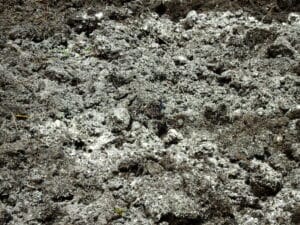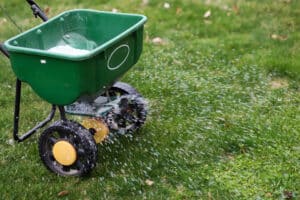Creeping Charlie, also known as ground ivy, is a fast-spreading vine often found in shady, moist areas of the yard. Once it takes hold, it can be hard to eliminate because it spreads through roots and runners. If you’re dealing with an infestation of this stubborn weed, there are ways to remove it and prevent it from coming back.
We’ll pass on some tips for eliminating creeping Charlie in your lawn and keeping it away. If you need help maintaining your lawn, we’ll also recommend our top lawn care company to keep your yard looking neat and weed-free.
Find Lawn Help
- See our list of top lawn care companies based on in-depth research.
- Select the company that best meets your needs.
- Get a free, no-obligation quote for your home.
Get a Quote From Lawn Professionals Near You
Get a quote in as little as 5 minutes
Clicking “Get Your Estimate” submits your data to Home Service Quotes, which will process your data in accordance with the Home Service Quotes Privacy Policy.

Lime Soil Amendment

Lawn Fertilization
What Is Creeping Charlie?
Creeping Charlie, also known as Glechoma hederacea, is a perennial member of the mint family. This European invader was brought over with good intentions in the 1800s as an ornamental plant, but it’s now a ubiquitous weed found all over the country, except for the Rocky Mountain states. It thrives in shady conditions where some turfgrasses cannot grow well, allowing it a foothold in lawns where it can, in time, take over.

How To Kill Creeping Charlie
There are three primary ways to get rid of the creeping Charlie or ground ivy attacking your lawn: by hand, by smothering, or by herbicide.
Method #1: Pull It Out By Hand
If there’s only a small patch of creeping Charlie, think about tackling it the old-fashioned way: by pulling it out by hand. This method is practical when you’ve just spotted some early growth of this weed in your lawn or landscape.
Consider manual removal if you have children, pets, or edible plants you don’t want to hit with more effective but chemical-based methods. However, it’s a labor-intensive technique that requires ongoing vigilance and might not be the most suitable if the invasion is extensive.
Here’s how you can pull out creeping Charlie by hand:
Step 1: Prune and Trim
To play it safe, put on protective gardening gloves—creeping Charlie can cause skin irritation, and some people are allergic to it. Trim the leaves, stems, and any vines that aren’t rooted to the ground with your garden shears. Doing this will expose the area you need to pull the roots out.
Place each and every trimming into a lawn waste bag—if you let any of the creeping Charlie remain on the ground, the rhizomes could take root again.
Step 2: Water the Surrounding Ground
You won’t be able to tug the creeping Charlie out, roots and all, if the ground is hard and dry. Soften the soil with enough water so that you won’t meet much resistance when you pull out the roots. The soil should be moist to the touch but not soggy. Wait about half an hour before the next step.
Step 3: Loosen the Soil
Take a pitchfork and loosen up the soil to make yanking out the creeping Charlie roots easier.
Step 4: Pull It Out
Firmly grasp the base of each root cluster and tug it up gently to remove all of the roots. If you meet resistance, use your pitchfork again to make the soil a little looser. Place all of the creeping Charlie into a lawn waste bag, as you did with the trimmings.
Step 5: Inspect the Area
Make sure you didn’t leave a single root that could allow the creeping Charlie to regrow. Take a trowel or cultivator and remove any additional rhizomes you find. This may take several passes.
Method #2: Smother It to Block Sunlight
Another way to tackle this weed is by smothering it, completely blocking it from the sunlight it needs to survive. As noted, creeping Charlie thrives in shady areas, but it still needs sunlight. Because of this, you’ll have to make sure you block all sunlight to the weed for an extended period.
Note that any plants underneath the cover will die, including any turfgrass and ornamental plants you may want to keep, so place the cover carefully. Again, this method is most effective for small patches of creeping Charlie.
Step 1: Cover the Creeping Charlie
Create a barrier that completely blocks out sunlight, using a piece of cardboard, a tarp, or some newspaper. Because the roots beneath the ground fan out, you’ll want to make sure the barrier extends about six to twelve inches around the vines and leaves on every side.
This method will do no good if there are any gaps at all, so you’ll need to weigh down the cover you’ve made with objects like bricks or rocks. This will stop the cover from blowing around and letting any sunlight in.
Step 2: Keep the Weed Covered Until It Turns Brown
This process will take time. Wait for a week, then take a peek to see if there is any green left in the area you’ve covered. If there is, put the cover back on and leave it in place for several days. You’ll know the cover has worked when the creeping Charlie is brown and shriveled.
Step 3: Remove the Creeping Charlie
Pull the dried-up Creeping Charlie out by the roots and dispose of it, once again paying careful attention not to leave any of it on your lawn.
Method #3: Kill It With Herbicide
When creeping Charlie has staged a full-scale attack and manual removal and smothering just won’t cut it, you may want to use synthetic herbicides. But be careful—many herbicides can kill your grass or ornamental plants alongside any unwanted weeds.
You can eradicate creeping Charlie using a targeted broadleaf herbicide that contains either dicamba or triclopyr. These ingredients should eliminate the weed while leaving your grass unharmed, but they will likely kill ornamental broadleaf plants.
The best time to kill creeping Charlie with herbicide is the days right before or right after the first frost.
Step 1: Prep the Herbicide
Put on protective goggles and gloves, then follow the directions on the herbicide’s label and mix it with water in a pump sprayer.
Step 2: Spray the Herbicide
Spray the herbicide onto the creeping Charlie. Concentrate on the leaves and stems and ensure they’re thoroughly soaked. You want the herbicide to soak down into the roots. Be careful not to overspray and hit any surrounding plants.
Step 3: Wait for Chemicals to Absorb
You should not mow for at least two days to give the creeping Charlie’s roots time to absorb the herbicide’s chemicals. Leave the area alone all winter. In spring, you can rake up the dead weeds.
Step 4: Repeat the Process
You will likely need to apply herbicide more than once. Read the manufacturer’s instructions for specific information.
Top Recommendation to Get Rid of Creeping Charlie
One of the most effective ways to keep creeping Charlie out of your yard is by maintaining a thick, healthy lawn, which naturally crowds out weeds. While DIY methods can work, professional help may offer longer-lasting results—especially for widespread infestations. TruGreen provides lawn care services, including targeted weed control and customized treatment plans, designed to improve your lawn’s overall health and resilience.
The company operates in 49 states and offers a satisfaction guarantee on its services. With multiple lawn care programs available, TruGreen can help address tough weeds like creeping Charlie without relying solely on chemical treatments.
FAQs About Creeping Charlie
What is the best time to get rid of creeping Charlie?
As a general rule, try to eradicate creeping Charlie as soon as you notice it. However, if you use herbicide, the best time to treat the weed is either just before or just after the first frost of the year, so long as the forecast doesn’t show rain or snow within 24 hours of the application. This should be in late fall, when the creeping Charlie hasn’t released seeds.
How do I prevent creeping Charlie?
The best way to prevent creeping Charlie or any weeds from overtaking your lawn is regular maintenance, which includes deep, infrequent watering, and grass cut long to compete with weeds.
What does creeping Charlie look like?
Creeping Charlie has square stems and creates a mat of green, kidney-shaped, scalloped-edged leaves. In springtime, creeping Charlie produces pale bluish-purple blossoms.
How does creeping Charlie spread?
Creeping Charlie spreads through its creeping stems that root at the nodes, growing low to the ground in moist, shady places. Left to its own devices, the weed will create a dense, mat-like ground cover.
Are there other plants in the same family as creeping Charlie?
Yes, the weed has an attractive relative called the Variegata, a popular cascading plant filler or ground cover sold in garden stores and nurseries.
Our Rating Methodology
The This Old House Reviews Team backs up our lawn recommendations with a detailed rating methodology that we use to objectively score each provider. We review lawn care plans and packages, navigate the provider website and speak with customer service representatives, request quotes, and analyze customer reviews for each provider. We then score the provider against our review standards for plan options, additional benefits and customizability, availability, trustworthiness, and customer service to arrive at a final score on a 5-point rating scale.


